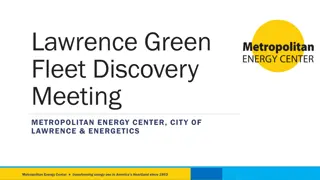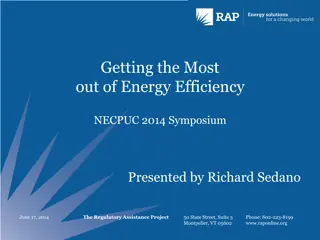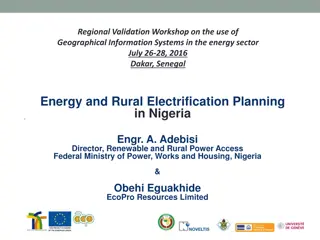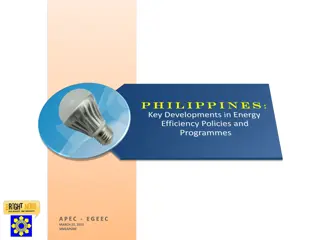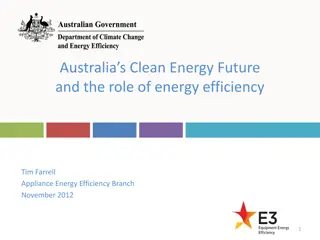Insights into Energy Efficiency, Electrification, and Flexibility in TSO Studies
French TSO RTE's webinar discusses the use of energy efficiency, electrification, and flexibility to decarbonize heating, focusing on strategies for reducing emissions through ambitious renovations and transitions to low-carbon energies like biomass and electricity. The National Low-Carbon Strategy aims to increase the use of electricity for heating, particularly through heat pumps, while addressing concerns related to emissions and security of supply.
Download Presentation

Please find below an Image/Link to download the presentation.
The content on the website is provided AS IS for your information and personal use only. It may not be sold, licensed, or shared on other websites without obtaining consent from the author.If you encounter any issues during the download, it is possible that the publisher has removed the file from their server.
You are allowed to download the files provided on this website for personal or commercial use, subject to the condition that they are used lawfully. All files are the property of their respective owners.
The content on the website is provided AS IS for your information and personal use only. It may not be sold, licensed, or shared on other websites without obtaining consent from the author.
E N D
Presentation Transcript
Energy Efficiency, Electrification and Flexibility in TSO s prospective studies: insights from the French TSO ENEFIRST Webinar - 2021, March 3 RTE, Power System Economics Division Bianka SHOAI-TEHRANI, Ph.D & Simona DE LAURETIS, Ph.D
1 Energy Efficiency and electrification as a way to decarbonise heating in buildings an analysis of the French strategy Bianka SHOAI-TEHRANI, Ph.D
Today, French households use mostly gas (~40%) and electricity (~40%) for heating 29 million households Joule heating (10 M) District heating & other (1 M) Fuel (3,5 M) Gas (12 M) Heat pumps (HP) (1 M) Biomass (1 M) Source : CEREN The National Low-Carbon Strategy in France aims at reducing emissions generated by heating through ambitious renovations, and through the shift to low carbon energies : biomass and electricity (since power generation is 93% low carbon in France). In particular, electrificity for heating should increase from 16% of final energy demand for heating today, to 28% in 2050, mostly through the use of heat pumps. 3
The National Low-Carbon Strategy relies on 3 measures to reduce CO2 emissions from heating in the building sector Energy performance of buildings (insulation) ~15 millions retrofits by 2035 (doubling the rythm and performance) Shift from fossil fuels to low-carbon energies for heating, including electricity High efficiency heating systems Households with electric heating : from 40% today to 50% in 2035 Heat pumps rather than Joule heating 4
Electrification of heating may raise some concerns Regarding emissions : it may activate fossil fuelled power generation Regarding security of supply : it may increase the winter peak Source : RTE, 2020 RTE, 2017 RTE and ADEME published in December 2020 an analysis of several scenarios considering a rise in the share of electric heating in France in 2035, with up to 16,5 households equipped with electric heating systems (Joule and HP) compared with 11 millions today, and with different levels of efficiency (share of HP, insulation of buildings). 5
Method Inputs Evolution of electricity consumption for heating Evolution of electricity consumption for other uses (EV, H2 ) Evolution of the power generation mix Simulation of the electricity system through an hourly model Outputs CO2 emissions System costs Impact on winter peak 6
If all measures are implemented Impacts on the electricity system are negligible On electricity consumption + Electrifying an additional 10% of households with heat pumps increases slightly electricity demand Annual electricity consumption for heating (adjusted for climatic differences) - 2035 (reference scenario) 58 TWh Retrofits on half of buildings reduce energy demand for heating (even if there is a rebound effect) Today 61 TWh = Electricity demand for heating is stable (about 12% of total electricity demand) One in ten" peak demand On winter peak: 2035 (reference scenario) -3 GW Slight decrease as well Today ~100 GW 7
If all measures are implemented The CO2 emissions reduction target is achieved 53 MtCO2 today CO2 emissions from fossil fuels are divided by two by 2035 (halfway from the zero emission target in 2050) Emissions from fossil fuelled heating 24,5 MtCO2 in 2035 without increasing emissions in the electricity sytem in France 20 MtCO2 aujourd hui Emissions from the French electricity system 11 MtCO2 en 2035 and even counting emissions on the European level In the reference scenario of the National Low Carbon strategy, there is no carbon leakage towards other countries due to the electrification of heating. 8
If efficiency targets are not met: Failing to achieve the retrofit target and electrifying with Joule heaters instead of heat pumps may rise the winter peak and bring constraints to the electricity system On electricity consumption Compared to the reference scenario, electricity consumption for heating would increase by 10 TWh Annual electricity consumption for heating (adjusted for climatic differences) 2035 Such an amount of energy does not represent any difficulty for the electricity system Today 72 TWh 61 TWh On winter peak: The winter peak would increase by several GW compared to today s levels One in ten" peak demand 2035 Higher need for flexibility Today +6 GW ~100 GW 9
If efficiency targets are not met: Failing to achieve the retrofit target and electrifying with Joule heaters instead of heat pumps generates 6 additional millions de tons of CO2 in France compared to the target 53 MtCO2 today 30 MtCO2 in 2035 Emissions from fossil fuelled heating 20 MtCO2 today Emissions from the French electricity system 11,5 MtCO2 in 2035 + ~6 MtCO2 / year in France + ~11 MtCO2 / an in Europe (including France) (in 2035, compared to the target) 10
If all targets are not met (efficiency & electrification): Failing all three targets (efficiency of buildings and heating systems, electrification) does not generate much constraint on the electricity system but causes 11 additional million tons of CO2 in France compared to the objective 53 MtCO2 today 35 MtCO2 in 2035 Emissions from fossil fuelled heating 20 MtCO2 today Emissions from the French electricity system 11,5 MtCO2 in 2035 + ~11 MtCO2 / year in France + ~14 MtCO2 / an in Europe (including France) (in 2035, compared to the target) 11
Conclusions & perspectives All measures need to be implemented to achieve the target in terms of CO2 emissions Avoided emissions from fossil fuelled heaters are not transferred to the electricity system either in France or Europe Each individual measure has an impact on emissions reductions Economic perspectives Such measures are costly : ~430 /tCO2 for the reference scenario Focusing on electrification through heat pumps only is economically more attractive (~100 /tCO2) but not sufficient to achieve the target Focusing on the most energy consuming buildings seems economically relevant (~290 /tCO2) 12
2 Demand-side flexibility Simona DE LAURETIS, Ph.D
Demand-side flexibility resources can provide a significant contribution to balancing the French power system Residential energy use Integrating high shares of renewables will increase the flexibility needs of the power system, while the available capacity from current flexible resources will be reduced Space heating Electric water heaters Air conditioning Demand-side flexibility will play an important role in future power systems, alongside other flexibility resources (thermal and renewable generators, storage, sector coupling and grids) Household appliances Electric vehicles Load management potential needs to be carefully assessed, taking into account the technical potential, but also the economic potential and public acceptability Industrial and commercial energy use Economic factors and public acceptability Space heating, lighting, air conditioning, cooling, manufacturing processes Technical potential Accessible potential 14
From the technical potential to the accessible potential The technical flexibility potential for each energy use depends on : Load curve for different uses on a Tuesday in january, in France - total energy consumption - higher energy volumes that can be moved in time mean higher flexibility - load profile if the uncontrolled load is placed on only a few hours of the day, with high peaks, management can have a higher benefit than for a relatively flat load Hour The economic analysis includes equipment costs and consumers demands for compensation Cooking Lighting Heating Which of the following reasons would encourage you to participate in demand-side management ? (source : CREDOC survey for RTE) Public acceptability does not depend only on financial compensation. In France, 18% of consumers say they would not participate in demand-response for any reason. 39% would participate if it allowed a reduction in the energy bill, and 27% would do so for environmental reasons. It allows to reduce the energy bill 39% It is better for the environment 27% It increases the security of supply 12% No reason would be sufficient 18% Do not know 4% 15
EV integration case study 2035 Crescendo : standard projections Opera : greater flexibility RTE published in 2019 an analysis of several scenarios considering a significant development of e-mobility in France in 2035, with up to 15,6 million electric vehicles (BEVs and PHEVs) Forte : stress for the electricity system Alto : expansion of shared autonomous vehicles The French power plant fleet will be more than capable of generating the amount of energy consumed by electric vehicles in all scenarios (e-mobility represents no more than 10% of total consumption) Piano : low-carbon mobility Charging curves for one million electric vehicles in the Crescendo intermediate scenario, as a function of the type of smart charging Power demands during busy holiday periods with excessive traffic present no cause for concern in terms of security of supply The challenge for the electricity system lies essentially in meeting peak demand for daily mobility charging needs Smart charging, even in its simplest form (TOU pricing) can significantly reduce peak load. Around 50% smart charging would be sufficient to ensure security of supply in the most challenging scenario 16
EV integration case study 2035 : benefits of EV load flexibility EV smarty charging leads to a better integration of RES production and results in significant savings for the electricity system, which may reach 1 billion euros a year Simple smart-charging solutions (e.g. TOU tariffs) can be sufficient to access a large part of the value associated with smart-charging Value associated with smart charging in the Crescendo scenario with 15,6 million EVs (variants on the development of smart charging, compared with a situation with no smart charging) V2G leads to additional savings, which are largely dependent on the prior deployment of simple forms of charging Participation of EVs in frequency regulation is useful, within a niche market 17
Total contribution of demand-side response to security of supply depends on the context Demand-response characteristics vary among different electricity uses. The service that can be rendered to the power system depends on load profile, behavioural constraints and presence of energy storage Estimated accessible demand-side flexibility in the residential sector These provisional estimates take into account activation times and constraints based on current rules of the French capacity market Adding up different contributions to estimate an equivalent demand-response capacity is a difficult exercice that requires careful analysis of the stress periods for the power system in the future, depending on the context We propose here an equivalent demand response capacity estimated for the coming decades, based on current guidelines for the French capacity certification mechanism (that do not reflect the context in the long term). low medium high low medium high low medium high Heating Electric vehicles Air conditioning Appliances Cooking DHW 18







